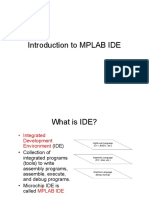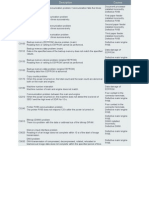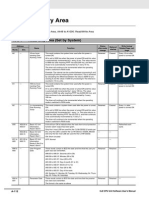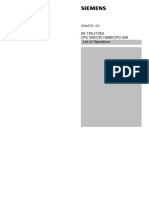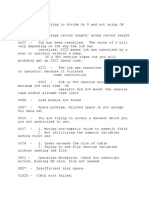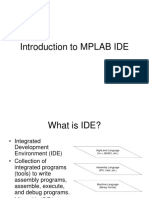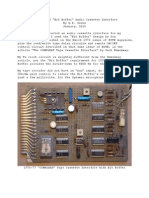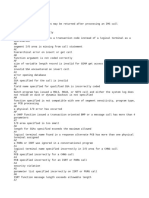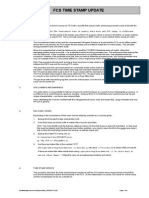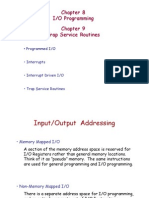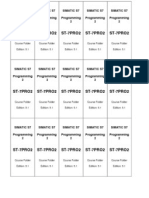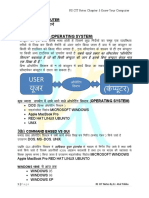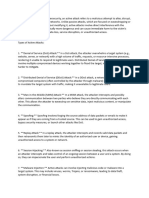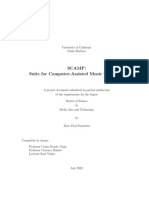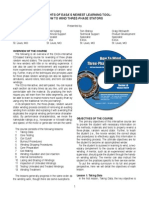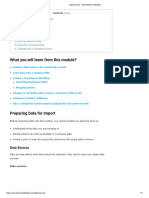APPENDIX A
884 PC ERROR CODES
The P190 screen includes an error line for reporting the various P1901884 PC or
Modbus communications error conditions. The error codes which may appear, and
their meanings, are listed in this appendix.
The P190 reports three distinct classes of errors: Panel, PC Link and PC Command
errors.
Type 1, Panel Error, are Modbus communications errors detected by the P19O’s
software. Both transmitted and received Modbus communications packets are
examined. Sometimes the communication attempt is repeated several times
before an error is declared.
TYPE l- ERROR: PANEL = XXX COMMUNICATION ERROR DETECTED
001 Loss of Data Set Ready on Port 1
002 Packet length exceeds maximum allowed to send
003 No response from PC after retries count exhausted
004 No valid response received from PC due to CRC error after retry count
exhausted
005 No valid response received from PC due to transmission of framing
error after retry count exhausted
006 l/O command is not valid to send to PC
007 The response from PC was legal but not valid for the current l/O
command
008 PC response to command was busy after retry count exhausted
009 PC reponse was not legal for the current l/O command
010 PC data received greater than panel memory allocated for receive
buffer
011 PC response is busy to a poll command after retry count exhausted
012 PC response to a poll is not valid
013 PC sequence byte incorrect, reset link, error recovery accomplished
014 Message size to send to PC is greater than PC maximum
015 PC packet number not in sequence or not equal to expected value for
current operation
TYPE 2 - ERROR: PCL = XXX COMMUNICATION ERROR REPORTED
001 Command function not supported by PC
002 Reserved
003 Reserved
004 PC CPU is not operating
005 Reserved
006 Reserved
007 Reserved
008 Reserved
009 Reserved
010 Reserved
011 Message size is greater than PC receive maximum
012 New message started before previous message completed. Previous
command aborted
013 PC reports current packet not next in sequence. Message aborted
014 Sequence error detected, error recovery successful
015 PC response message is greater than amximum message, message
aborted
All other codes are reserved.
A-l
�884 PC ERROR MESSAGE DEFINITIONS
TYPE 3 - ERROR: PC = XXX PC INDICATES USER ERROR
001 Another user is logged in
002 Invalid password received
003 Search failed
004 Not on running PC
005 Memory is protected
006 Running PC
007 PC is not running
008 Cannot start from state
009 User is not logged in
010 PC cannot support function
011 Coil is already used
012 Latch is already used
013 Network out of range
014 User logic overflow
015 User logic overflow or replace
016 Network skipped
017 Not an 884 network
018 PC is corrupt
019 PC boundary violation
020 Scan interval is too large
021 Feature is not implemented
022 to 068 are error code numbers not used at this time
069 Function is not supported
070 Access is denied
071 Maximum number of references is exceeded
072 Invalid reference type
073 Invalid reference type
074 Discrete not disabled
075 Data is illegal
076 Cannot write input registers
077 PPE not even
078 PPE invalid row
079 No Start of Network (SON) node
080 Invalid opcode
081 Too many columns
082 Missing nodes
083 Unexpected elements
084 Row contact mismatch
085 Embedded coil
086 Illegal constant
088 Must be a 16 boundary
089 Data length mismatch
090 Hook not configured
091 Not configurable
092 Read only table
093 Invalid table offset
A-2
� 884 PC ERROR MESSAGE DEFINITIONS
TYPE 3 - ERROR: PC = XX PC INDICATES USER ERROR (cont’d)
095 Bad table data
096 Bad memory type
097 Bad memory address
098 Comm parameters invalid
099 Zero references requested
100 Invalid IOP
101 Invalid drop
102 Invalid rack
103 Invalid data
104 Illegal comm setting
105 to 125 are error code numbers not used at this time.
126 Invalid constant index
A-3
� APPENDIX B
PC MEMORY ERROR
If the PC encounters an error, the PC Memory Error screen appears. If the error
occurs during the initial loading of the programmer and configurator tape, press
the ALL MEMORY software label key. This initializes all PC memory.
If, however, this is not the initial loading, follow the recommended directions
displayed on the screen:
INITIALIZE TABLES TO CLEAR MEMORY: C
Enter “C” and press the INIT TABLE software label key. The next screen to appear
displays two software label keys: PROCEED and CANCEL. If the CANCEL software
label key is pressed, the current operation will not be completed and you will be
returned to the previous menu.
If the PROCEED software label key is pressed, the current operation will be
performed, and the Power-up and Attach screen reappears. Press the ATTACH
software label key and the PC Operations Menu screen appears.
B-l
�� APPENDIX C
PASSWORD OPERATIONS
C.l PASSWORD OPERATIONS (PASSWD OPS)
Press PASSWD OPS software label key to display the Password Table.
The 884 PC and P190 use passwords to protect the 884 PC’s memory. The use of
a password is optional. If you do not enter a password, the system defaults to
Level 3. If a password has been entered it can only be changed by someone logged
on with Level 3 privleges. If you try to ATTACH to a password protected P1901884
PC and do not know the password, turn the Memory Protect key (on the P190) to
the UNLOCK position to proceed from the Password screen. There are four
password levels, each allowing a higher memory access than the previous. Level
0 does not require a password. The password can contain a maximum of eight
alphanumeric characters.
Level 0 - allows you to read any of the 884 PC’s memory except the password
table. If you ATTACH to a password protected P1901884 PC and do not know the
password, turn the Memory Protect key on the P190 to the UNLOCK position to
proceed from the Password screen. Memory cannot be altered.
Level 1 - allows you to write references, enable or disable coils and discrete
inputs and start, stop or clear the PC.
Level 2 - allows you to enter new networks and/or alter existing logic. Also the
scan rate and Modbus port parameters can be set.
Level 3 - allows you to configure the 884 PC’s I/O specifications. It also allows
the user to read and change the password table.
Access to any given level implies access to all the lower levels without use of the
associated passwords.
The password table is entered the first time the PC is configured. To enter
passwords, press the PSWD OPS software label key. The following software label
keys appear on the screen:
DELETE1 DELETE2 DELETE3
ENTER 1 ENTER2 ENTER3 WEV MENU
C.l .l Enter Password
A prompt appears on the screen: ENTER PASSWORD (MAX. 8 CHARACTERS),
THEN PRESS DESIRED LEVEL.
Type in the password and press the appropriate software label key (i.e., ENTER 2,
enters a level 2 password. When a password is entered into level 1, levels 2 and
3 receive the same password if they were previously blank, or if they contained the
same password.
When a password is entered into Level 2, level 3 receives the same password if
level 3 is blank or had the same password as level 2.
NOTE
Blanks (spaces) will not be accepted. Only printable
characters are atlowed.
C-l
�PASSWORD OPERATIONS
C.1.2 Delete Password
To delete a password or passwords, press the shift key and appropriate software
label key: DELETE 1, DELETE 2, or DELETE 3.
If the level 3 password is deleted, and a level 2 password exists, the level 2
password is automatically displayed in level 3 as well as in level 2.
c-2
